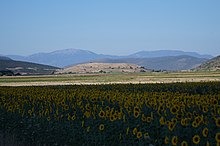Hyampolis
Hyampolis ( Greek Ὑάμπολις ( f. Sg. )) Is an ancient city in Greece .
location
Hyampolis is located in the Assos Valley in the east of the Phocis landscape , about two and a half kilometers west of Abai . The city is built on a hill about 30 meters high and its highest point is about 270 meters. To the north of the hill, the Exarchos brook flows into the Assos (today: Bogdanorema). Hyampolis was on the most important route from central to northern Greece. The Strait of Orchomenos met the south-north connection from Livadia to Opus from the east .
history
Hyampolis, which was also called Hya for short, is said to have been founded by the Hyanten after they were expelled from Thebes by Kadmos . The city was also mentioned in Homer's Iliad (ship catalog ). It was supposedly named after Hyamos , the son of Lykoros , who founded the city after the Deucalionic flood .
Around 490 BC The Thessalians invaded Phocis and devastated the country. At Hyampolis, the Thessalian cavalry was defeated by a trick. Empty amphorae had been buried and covered with earth at a narrow passage near the city . When the cavalry passed this point, the amphorae broke under the weight, the horses fell into the hole and fell. 480 BC During the Persian Wars , the city was destroyed by the Persians . In 395 the Boioter besieged the city, but could not take it. Jason , tyrant of Pherai , destroyed the unprotected lower city in 371 on his return from the Battle of Leuctra . In 346 BC Another attack followed, this time by Philip II of Macedonia , who destroyed Hyampolis again. After the reconstruction, the city was conquered by Titus Quinctius Flamininus in 198 and fell under Roman rule. Hadrian had a portico built in the city; Emperor Septimius Severus also appears on an inscription .
Pausanias reports that there was an agora , a theater and a town hall in Hyampolis . It is said that there was only one well within the city wall. The main deity was Artemis Elaphebolos ( Greek Έλαφηβόλος = the (deer) hunter ) and in her honor a festival is said to have been celebrated in her temple twice a year. The sanctuary and town were used and settled until the Roman Empire. According to an inscription from the reign of Trajan , there was also a sanctuary in Hyampolis for the Egyptian gods Serapis , Isis and Bastet . Another inscription mentions Anubis .
description
Today only the 800 meter long wall ring from the 4th century BC remains. Chr. And some other remains. The city covered an area of about 4.6 hectares. In the north and northwest, the city wall up to a height of three meters and the foundations of three towers are visible. A few remains of the former city gate can still be seen in the south. The masonry consists of horizontal, isodomic ashlar layers and probably dates from the 3rd century BC. A cistern was found within the walls, which is believed to be the source mentioned by Pausanias.
Five kilometers north of Hyampolis are the remains of a sanctuary near Kalapodi . At first it was assumed that the temple of Artemis Elaphebolos of Hyampolis was discovered there, but the latest findings indicate that it is the sanctuary of Apollo at Abai. About two kilometers south, on the southwestern edge of the Kastro mountain , the remains of a late Helladic settlement have been found near Smixi .
exploration
The English archaeologist William Martin Leake visited Hyampolis in the early 19th century and described the site. In the spring of 1894, the British School at Athens conducted archaeological excavations under the direction of AG Bather and VW Yorke.
literature
- VW Yorke: Excavations at Abae and Hyampolis in Phocis . In: The Journal of Hellenic Studies . Volume 16, 1896, pp. 291-312 ( online ).
- Felix Bölte : Hyampolis . In: Paulys Realencyclopadie der classischen Antiquity Science (RE). Volume IX, 1, Stuttgart 1914, Col. 17-22.
- Ernst Meyer : Hyampolis. In: The Little Pauly (KlP). Volume 2, Stuttgart 1967, column 1255 f.
Web links
Remarks
- ↑ Strabo , Geography 9,3,15.
- ↑ Homer, Iliad 2,521.
- ↑ Scholion to Euripides , Orestes 1094.
- ↑ Herodotus , Histories 8:28; Diodor , Bibliotheke historike 16,56,1.
- ↑ Herodotus, Histories 8:33.
- ↑ Xenophon , Hellenica 6,4,27.
- ↑ Titus Livius , Roman History 32:18.
- ^ Pausanias, Travels in Greece 10: 35, 5-7.
- ↑ Inscriptiones Graecae 9,1,86 ( online ( memento of the original dated August 23, 2013) Info: The archive link has been inserted automatically and has not yet been checked. Please check the original and archive link according to the instructions and then remove this note. ).
- ↑ Insciptiones Graecae 9,1,92.
- ^ Rainer Felsch: Kalapodi. Report on the excavations in the sanctuary of Artemis Elaphebolos and Apollo of Hyampolis . In: Archäologischer Anzeiger 1987, pp. 1–26; Rainer Felsch: Kalapodi. Results of the excavations in the sanctuary of Artemis and Apollon of Hyampolis in the ancient Phokis vol. 1, Zabern, Mainz 1996.
- ^ William Martin Leake: Travels in Northern Greece , Volume 2, London 1835, pp. 167-170 ( online ).
- ^ VW Yorke: Excavations at Abae and Hyampolis in Phocis . In: The Journal of Hellenic Studies . Volume 16, 1896, pp. 291-312 ( online ).
Coordinates: 38 ° 35 ′ 30 ″ N , 22 ° 54 ′ 55 ″ E


